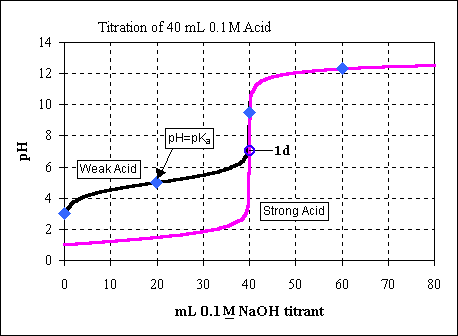A titration is performed using by adding 0.100 M NaOH to 40.0 mL of 0.1 M
HCl.
d) Calculate the pH at the equivalence point.
Answer:
The equivalence point is the point in the titration where;
moles of base (NaOH) = moles of acid (HCl)
Since we are adding the base to the acid, we know how many moles
of acid are present;

We need the same number of moles of base (NaOH) at the equivalence
point;
0.00400 moles NaOH
So the 'ICE table' now looks like;
|
NaOH(aq)
|
+ HCl(aq)
|
--->
|
NaCl(aq)
|
+ H2O(aq)
|
I
|
0.00400 mol
|
0.00400 mol
|
|
0
|
-
|
C
|
|
|
|
|
|
F
|
|
|
|
|
|
Since K for the reaction is large, the reaction will go to
completion. This means that the reactant in the smallest amount will completely
react. At this point in the titration there are fewer moles of base compared
to acid. So all the base reacts. Adding this to the 'ICE table' we have;
|
NaOH(aq)
|
+ HCl(aq)
|
--->
|
NaCl(aq)
|
+ H2O(aq)
|
I
|
0.00400 mol
|
0.00400 mol
|
|
0
|
-
|
C
|
-0.00400 mol
|
-0.00400 mol
|
|
+0.00400 mol
|
-
|
F
|
|
|
|
|
|
The final amount of each species can be obtained just as it
always has been in the other ICE tables, by adding the change to the initial
amount.
|
NaOH(aq)
|
+ HCl(aq)
|
--->
|
NaCl(aq)
|
+ H2O(aq)
|
I
|
0.00400 mol
|
0.00400 mol
|
|
0
|
-
|
C
|
-0.00400 mol
|
-0.00400 mol
|
|
+0.00400 mol
|
-
|
F
|
0
|
0
|
|
+0.00400 mol
|
|
Focusing on the Final row there is only salt present.
To calculate the pH we must recognize the type of system we
have. To do that we look at the final row and see what species are present.
In this case there are only moles of salt (NaCl). But the salt of a strong
acid and a strong base does not effect the pH of water. So the pH of the mixture
at the equivalence point is the same as the pH of water, 7.
We can see this point on the titration curve (as point 1d).
